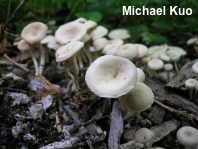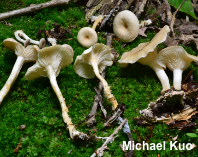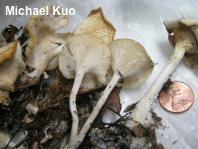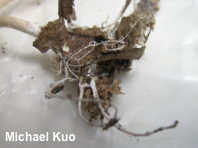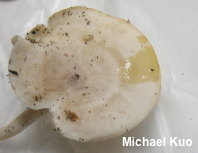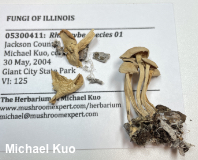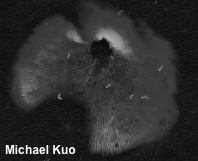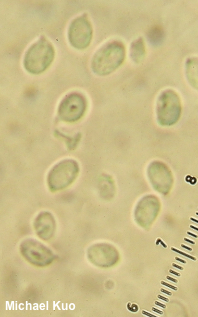| Major Groups > Gilled Mushrooms > Pale-Spored > Clitocyboid Mushrooms > Rhizocybe species 01 |

|
Rhizocybe species 01 [Basidiomycota > Agaricales > Tricholomataceae > Rhizocybe...] by Michael Kuo In central Illinois, this mushroom is a fairly common find in springtime. It is a pale-capped clitocyboid mushroom growing in troops and loose clusters on the deadwood and woody debris of hardwoods, featuring prominent white rhizomorphs that extend into the substrate. For almost two decades I thought this mushroom was Clitocybe eccentrica, but I have now convinced myself that it is, actually, an undescribed species of Rhizocybe (a newly erected genus for some clitocyboid mushrooms; see the discussion below). The two species can be separated by their fruiting times, their stem bases (the stem of Clitocybe eccentrica is much more prominently hairy), their cap colors, the fact that the cap of Clitocybe eccentrica tends to become split and lobed, and the colors assumed by specimens dried for the herbarium. Regular readers know that I am a taxonomic "lumper" whenever possible because painting genera in broader strokes is a better way to communicate evolution to non-specialists. In the case of "Clitocybe," however, evidence from contemporary studies (see e. g. Alvarado et al. 2015, 2018) makes it clear that the traditionally conceived genus is a hot mess, and that no amount of rational "lumping" will avoid the separation of multiple genera—unless you want to lump Collybia, Lyophyllum, Entoloma, and Tricholoma in with Clitocybe and create "Monstrocybe," the monster genus. So Rhizocybe is a thing, and it appears to correspond, more or less, to the traditional subgenus Vernae of Clitocybe: "vernae" as in vernal (occurring in spring), with species growing from wood and possessing rhizomorphs (Harmaja 1969, Bigelow 1982). The two best-known species, Rhizocybe vermicularis and Rhizocybe pruinosa, are decomposers of conifer wood and feature more pigmented caps; the species described here is quite pale, and appears on the wood of hardwoods. Description: Ecology: Saprobic; growing gregariously or in loose clusters on the deadwood or woody debris of hardwoods in oak-hickory forests; spring; distribution uncertain. The illustrated and described collections are from Illinois. Cap: 2–6 cm across; planoconvex, sometimes with a shallow navel, becoming shallowly vase-shaped with development; thin; dry; bald; very pale caramel-brownish when young, becoming whitish; the margin not lined. Gills: Running down the stem; close or nearly crowded; short-gills frequent; white. Stem: 3–7 cm long; 2–6 mm thick; more or less equal, above a slightly swollen base; dry; bald above, fuzzy near the base; with numerous white rhizomorphs attached. Flesh: Thin; whitish. Odor and Taste: Odor not distinctive; taste slightly bitter, or not distinctive. Chemical Reactions: KOH slowly yellowish to yellow on cap surface. Dried Specimens: Cap and stem creamy white; gills slightly brownish. Spore Print: White. Microscopic Details: Spores 4–5 x 2–3.5 µm; ellipsoid; with a tiny apiculus; smooth; hyaline in KOH; inamyloid; not adhering in groups. Basidia 24–27 x 4–4.5 µm; subclavate; 4-sterigmate. Cystidia not found. Pileipellis poorly defined; hyphae at surface tangled, 2.5–5 µm wide, smooth, hyaline to yellow in KOH; clamp connections present. REFERENCES: (Kuo & Methven, 2014.) Herb. Kuo 06150306, 05250404, 05300401, 05281002, 05061205, 05291305, 05271802. This site contains no information about the edibility or toxicity of mushrooms. |
© MushroomExpert.Com |
|
Cite this page as: Kuo, M. (2021, October). Rhizocybe species 01. Retrieved from the MushroomExpert.Com Web site: http://www.mushroomexpert.com/rhizocybe_species_01.html |
